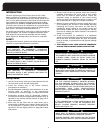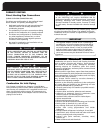
FURNACE SIZING
The maximum hourly heat loss for each heated space shall
be calculated in accordance with the procedures described
i
n Manual J titled, "Load Calculation" published by the Air
Conditioning Contractors of America, or by any other
method which is suitable for local conditions, provided the
results obtained are in substantial agreement with, and not
less than those obtained using the procedure described in
t
heir manual.
In Canada, the maximum hourly heat loss for each heated
space shall be calculated in accordance with the procedures
d
escribed in the manuals of the Heating, Refrigeration and
Air Conditioning Institute of Canada (HRAI), or by any other
method which is suitable for local conditions, provided the
results obtained are in substantial agreement with, and not
less than those obtained using the procedure described in
their manuals.
If the installation is a retrofit application, do not rely on the
capacity of the existing heating equipment as a method to
size the new fur
nace. Many of the heat transfer multiples
listed in earlier versions of load calculation manuals were
much higher than those listed in more recent editions. It is
possible that energy saving measures have been completed
since the installation of the existing furnace. This might
include additional insulation in the attic or walls, the
application of sprayed foam insulation, the addition of
storm windows and doors, weather stripping, caulking, etc.
Many of the older furnaces were equipped with large belt
drive blower systems, operating at low RPMs. If replacing an
existing furnace, be sure that the existing ductwork can
handle the amount of airflow necessary for a reasonable
temperature rise. Most older gas furnaces operated with a
system temperature rise of 70 - 100°F. This series furnace has
been designed for operation with a system temperature rise
(
∆T) of 35 - 65°F. If the furnace selected has an identical
output capacity as the original furnace, a substantial
increase in system airflow will be required.
4
Existing ductwork should be assessed for its air handling
capabilities. For residential applications, the recommended
air velocity of a supply air trunk duct is 700 feet per minute
(fpm), and should not exceed 900 fpm. The recommended
air velocity of a supply air branch run is 600 fpm, and should
not exceed 900 fpm. These values are slightly lower for
f
lexible ducting. The recommended air velocity of a return
a
ir trunk duct is 600 fpm, and should not exceed 700 fpm.
The recommended and maximum air velocity of a return air
branch is 600 fpm.
The equal friction chart, as published by ASHRAE and HRAI,
is the basis for the various air duct calculators available
through heating supply companies.
The return air system is equally as important as the
supply air system. An undersized return air system will
prevent sufficient quantities of air from reaching the
supply air system, properly sized or otherwise, and will
consequently reduce the service life of the furnace and
its components.
IMPORTANT
INSPECTION / ACCESS PANEL
If an air conditioning coil is not to be used in the supply air
plenum, it is recommended that the outlet duct be provided
with a removable access panel, which is accessible when
installed so the heat exchanger may be viewed for possible
openings using light assistance or a probe that can be
inserted for sampling the air stream. The access cover must
be fabricated in such a manner as to prevent leaks.
AIR CONDITIONING
This furnace may be used as part of an air conditioning
system. The furnace wiring and control system are “air
conditioning ready”. There are the following factors to
consider:
• The air conditioning evaporator coil must be
downstream of the heat exchanger. The cooled air
passing over the warm ambient air inside the heat
exchanger tubes can cause condensation inside the
tubes, resulting in corrosion and premature failure.
• A parallel duct system can be installed to direct the air
from the furnace through the evaporator coil only. Use
dampers or other means to bypass the heat exchanger.
If [summer/winter] dampers are used, they should be
interlocked to prevent system operation unless the
dampers are in the full open or full closed position.


















